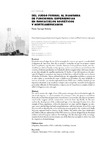Mostrar o rexistro simple do ítem
Del juego formal al diagrama de funciones: experiencias en rascacielos soviéticos y norteamericanos
| dc.contributor.author | Larripa Artieda, Víctor | es_ES |
| dc.date.accessioned | 2015-04-09T08:18:29Z | |
| dc.date.available | 2015-04-09T08:18:29Z | |
| dc.date.issued | 2014 | es_ES |
| dc.identifier.citation | Boletín Académico, 2014, 4: 1-12. ISSN 2173-6723 | es_ES |
| dc.identifier.issn | 2173-6723 | es_ES |
| dc.identifier.uri | http://hdl.handle.net/2183/14362 | |
| dc.description.abstract | [Resumen] El artículo narra el origen de una de las estrategias de proyecto que aportó la modernidad: el diagrama de funciones. Para ello se analiza el momento en que los pioneros viraron desde sus primeros experimentos formales abstractos hacia posiciones mucho más funcionalistas y objetivas basadas en el programa y en la construcción, no ya en la forma. En concreto, el discurso profundiza en el desarrollo del tipo arquitectónico del rascacielos por ser un claro ejemplo de aquellas experiencias. De hecho, el tipo del rascacielos y la estrategia del diagrama comparten una trayectoria histórica y cultural similar: ambos fueron inventados en Estados Unidos, reformulados por las vanguardias soviéticas y europeas en los años veinte, y exportados de nuevo a América en los treinta. De estas vicisitudes se hace eco el artículo, que termina explicando la torre PSFS como colofón: diseñado por un arquitecto americano y un arquitecto europeo, este es el primer rascacielos de la segunda generación edificado en Norteamérica y supone uno de los primeros ejemplos donde se utilizó el diagrama como estrategia | es_ES |
| dc.description.abstract | [Abstract] The article narrates the origin of one of the project strategies that modernity brought: the functional diagram. For this, it examines the moment in which the pioneers veered from their early abstract formal experiments towards more functionalist and objective positions based on the program and the construction, not in the form. Specifi cally, the discourse explores the development of the architectural type of the skyscraper because it is a clear example of those experiences. In fact, the skyscraper -as a type- and the diagram -as a strategy-, share a similar historical and cultural trajectory: both were invented in the U.S., then they were reformulated by the soviet and European avant-garde in the twenties, and fi nally they were exported back to America in the thirties. Th e article eches these vicissitudes, and fi nishes with an explanation of the PSFS tower as a climax: designed by an American architect and an European architect, this building is the fi rst skyscraper of the second generation built in America and represents one of the fi rst clear examples in which was used the diagram as a formal strategy. | es_ES |
| dc.language.iso | spa | es_ES |
| dc.publisher | Universidade da Coruña | es_ES |
| dc.subject | Diagrama | es_ES |
| dc.subject | Rascacielos | es_ES |
| dc.subject | PSFS | es_ES |
| dc.subject | Ladovsky | es_ES |
| dc.subject | Gínzburg | es_ES |
| dc.subject | Lescaze | es_ES |
| dc.subject | Diagram | es_ES |
| dc.subject | Skyscrapers | es_ES |
| dc.subject | PSFS | es_ES |
| dc.subject | Ladovsky | es_ES |
| dc.subject | Gínzburg | es_ES |
| dc.subject | Lescaze | es_ES |
| dc.title | Del juego formal al diagrama de funciones: experiencias en rascacielos soviéticos y norteamericanos | es_ES |
| dc.title.alternative | From the formal play to the functional diagram: Experiences in Soviet and North American skyscrapers | es_ES |
| dc.type | info:eu-repo/semantics/article | es_ES |
| dc.rights.access | info:eu-repo/semantics/openAccess | es_ES |






